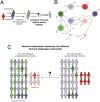Impact of waning immunity against SARS-CoV-2 severity exacerbated by vaccine hesitancy
- PMID: 39102402
- PMCID: PMC11299835
- DOI: 10.1371/journal.pcbi.1012211
Impact of waning immunity against SARS-CoV-2 severity exacerbated by vaccine hesitancy
Abstract
The SARS-CoV-2 pandemic has generated a considerable number of infections and associated morbidity and mortality across the world. Recovery from these infections, combined with the onset of large-scale vaccination, have led to rapidly-changing population-level immunological landscapes. In turn, these complexities have highlighted a number of important unknowns related to the breadth and strength of immunity following recovery or vaccination. Using simple mathematical models, we investigate the medium-term impacts of waning immunity against severe disease on immuno-epidemiological dynamics. We find that uncertainties in the duration of severity-blocking immunity (imparted by either infection or vaccination) can lead to a large range of medium-term population-level outcomes (i.e. infection characteristics and immune landscapes). Furthermore, we show that epidemiological dynamics are sensitive to the strength and duration of underlying host immune responses; this implies that determining infection levels from hospitalizations requires accurate estimates of these immune parameters. More durable vaccines both reduce these uncertainties and alleviate the burden of SARS-CoV-2 in pessimistic outcomes. However, heterogeneity in vaccine uptake drastically changes immune landscapes toward larger fractions of individuals with waned severity-blocking immunity. In particular, if hesitancy is substantial, more robust vaccines have almost no effects on population-level immuno-epidemiology, even if vaccination rates are compensatorily high among vaccine-adopters. This pessimistic scenario for vaccination heterogeneity arises because those few individuals that are vaccine-adopters are so readily re-vaccinated that the duration of vaccinal immunity has no appreciable consequences on their immune status. Furthermore, we find that this effect is heightened if vaccine-hesitants have increased transmissibility (e.g. due to riskier behavior). Overall, our results illustrate the necessity to characterize both transmission-blocking and severity-blocking immune time scales. Our findings also underline the importance of developing robust next-generation vaccines with equitable mass vaccine deployment.
Copyright: © 2024 Saad-Roy et al. This is an open access article distributed under the terms of the Creative Commons Attribution License, which permits unrestricted use, distribution, and reproduction in any medium, provided the original author and source are credited.
Conflict of interest statement
The authors have declared that no competing interests exist.
Figures






Similar articles
-
How Does Vaccine-Induced Immunity Compare to Infection-Acquired Immunity in the Dynamics of COVID-19?Pathogens. 2025 Feb 11;14(2):179. doi: 10.3390/pathogens14020179. Pathogens. 2025. PMID: 40005554 Free PMC article.
-
Insights into COVID-19 Vaccine Development Based on Immunogenic Structural Proteins of SARS-CoV-2, Host Immune Responses, and Herd Immunity.Cells. 2021 Oct 29;10(11):2949. doi: 10.3390/cells10112949. Cells. 2021. PMID: 34831172 Free PMC article. Review.
-
Optimal SARS-CoV-2 vaccine allocation using real-time attack-rate estimates in Rhode Island and Massachusetts.BMC Med. 2021 Jul 13;19(1):162. doi: 10.1186/s12916-021-02038-w. BMC Med. 2021. PMID: 34253200 Free PMC article.
-
An Intranasal OMV-Based Vaccine Induces High Mucosal and Systemic Protecting Immunity Against a SARS-CoV-2 Infection.Front Immunol. 2021 Dec 17;12:781280. doi: 10.3389/fimmu.2021.781280. eCollection 2021. Front Immunol. 2021. PMID: 34987509 Free PMC article.
-
Mitigating Covid-19 in the face of emerging virus variants, breakthrough infections and vaccine hesitancy.J Autoimmun. 2022 Feb;127:102792. doi: 10.1016/j.jaut.2021.102792. Epub 2022 Jan 1. J Autoimmun. 2022. PMID: 34995958 Free PMC article. Review.
Cited by
-
The ghost of infections past: Accounting for heterogeneity in individual infection history improves accuracy in epidemic forecasting.PLoS Biol. 2025 Aug 11;23(8):e3003311. doi: 10.1371/journal.pbio.3003311. eCollection 2025 Aug. PLoS Biol. 2025. PMID: 40788849 Free PMC article.
-
Beyond the Pandemic Era: Recent Advances and Efficacy of SARS-CoV-2 Vaccines Against Emerging Variants of Concern.Vaccines (Basel). 2025 Apr 17;13(4):424. doi: 10.3390/vaccines13040424. Vaccines (Basel). 2025. PMID: 40333293 Free PMC article. Review.
-
A conceptual health state diagram for modelling the transmission of a (re)emerging infectious respiratory disease in a human population.BMC Infect Dis. 2024 Oct 24;24(1):1198. doi: 10.1186/s12879-024-10017-8. BMC Infect Dis. 2024. PMID: 39448915 Free PMC article.
-
COVID-19 Vaccination Still Makes Sense: Insights on Pneumonia Risk and Hospitalization from a Large-Scale Study at an Academic Tertiary Center in Italy.Microorganisms. 2025 Jul 25;13(8):1744. doi: 10.3390/microorganisms13081744. Microorganisms. 2025. PMID: 40871247 Free PMC article.
References
-
- Anderson RM, May RM. Infectious diseases of humans: dynamics and control. Oxford, UK: Oxford University Press; 1991.
MeSH terms
Substances
Grants and funding
LinkOut - more resources
Full Text Sources
Medical
Miscellaneous

